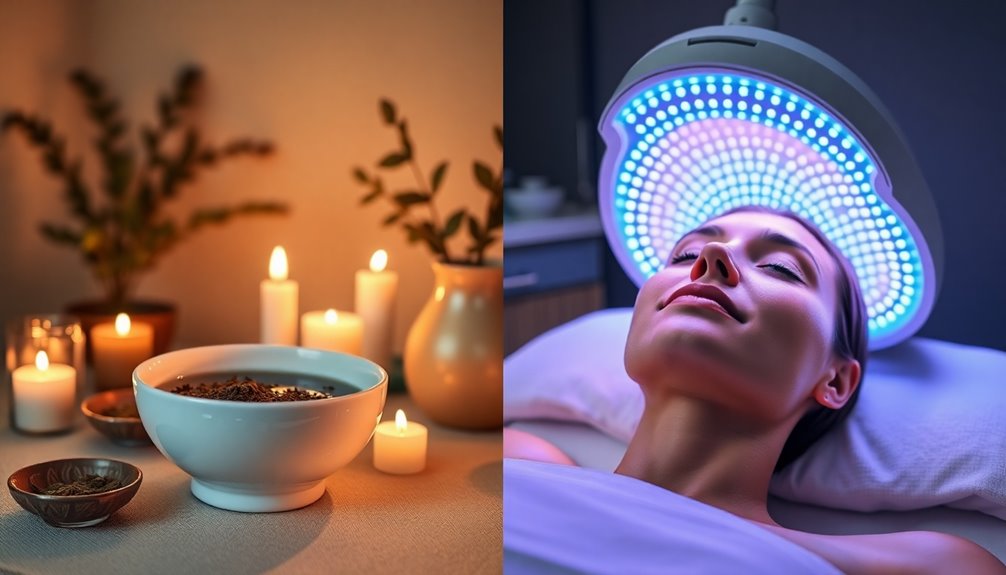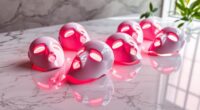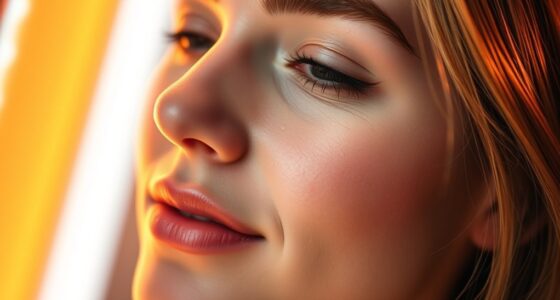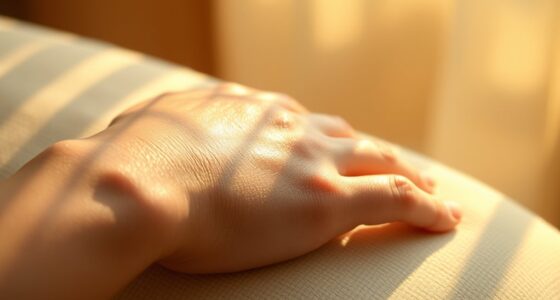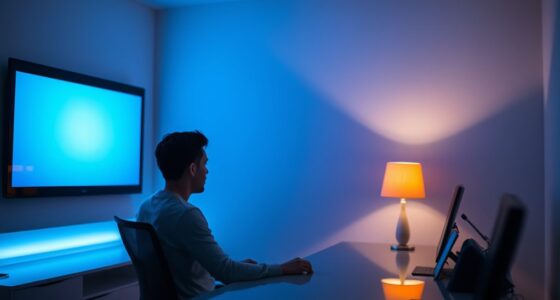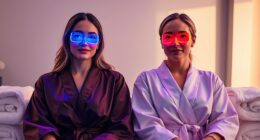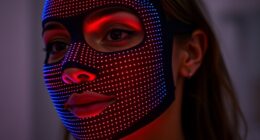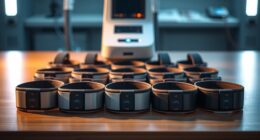When comparing LED therapy to traditional skincare treatments, you'll find LED therapy often comes out on top. It's non-invasive, safe for all skin types, and delivers noticeable results quickly, promoting collagen production and reducing inflammation. Sessions are generally more affordable and require less downtime. Unlike chemical peels or laser treatments, LED therapy minimizes risks and side effects, making it suitable for sensitive skin. However, both treatments can complement each other for optimal results. If you're curious about how to choose the best option for your skin, there's more to explore about their unique advantages and proper usage.
Key Takeaways
- LED therapy is non-invasive and pain-free, while traditional treatments often involve discomfort and downtime.
- LED therapy shows quicker results in skin improvement compared to the longer intervals required for traditional methods.
- It is safer for all skin types, including sensitive skin, unlike some traditional treatments that may cause irritation.
- LED therapy is generally more cost-effective, with sessions priced between $25 and $85, compared to higher costs for traditional treatments.
- Both treatments can complement each other, allowing for a tailored approach to address multiple skin concerns simultaneously.
Non-Invasive Benefits
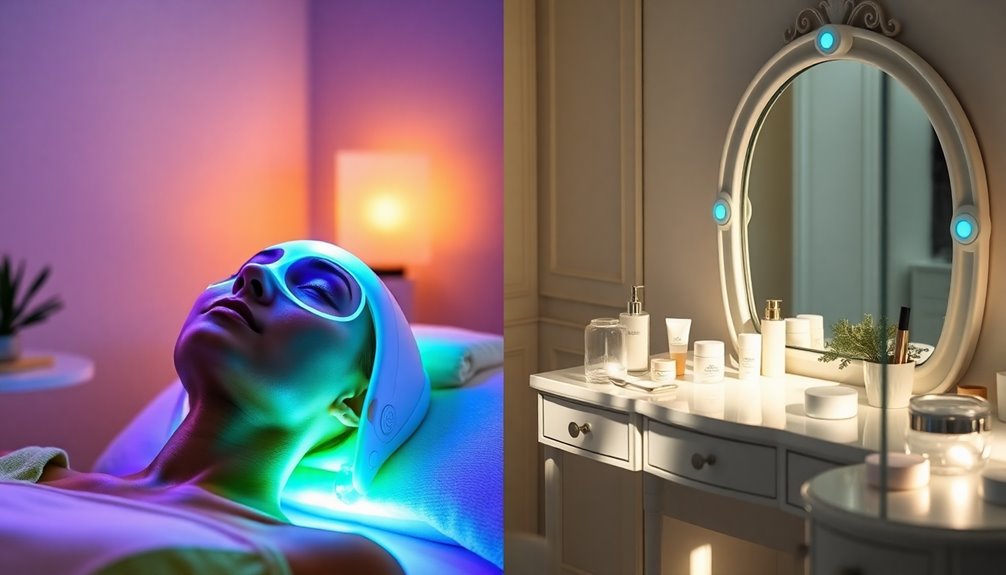
When it comes to skincare, one standout option is LED light therapy, which offers several non-invasive benefits that make it appealing. This innovative treatment utilizes different wavelengths of light to target various skin concerns, such as acne, aging, and inflammation. Combining LED therapy and skincare can enhance the efficacy of topical products, allowing them to penetrate deeper into the skin for better results. As a result, many individuals turn to this advanced method as a complementary approach to their existing skincare routines.
This treatment is completely pain-free and requires no downtime, allowing you to get back to your day immediately. Unlike chemical peels or microneedling, which can irritate the skin or cause discomfort, LED therapy is suitable for all skin types, including sensitive and acne-prone skin. Its versatility allows it to address various skin issues like acne, wrinkles, and pigmentation without the risks associated with harsher treatments. Plus, you can easily integrate LED therapy with other skincare treatments, making it a flexible choice for enhancing your overall routine.
Additionally, this therapy effectively kills acne-causing bacteria, which further contributes to its efficacy in treating breakout-prone skin.
Enjoy glowing skin without the hassle!
Efficacy and Results
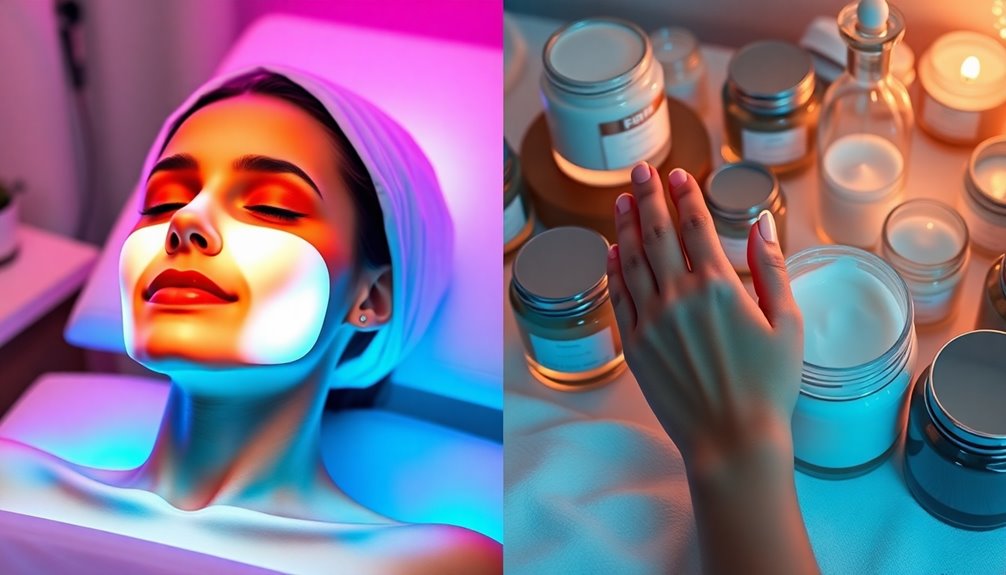
LED therapy shines in boosting collagen production, enhancing skin elasticity while reducing fine lines and wrinkles. It excels in managing mild to moderate acne by calming inflammation and balancing sebum levels. Additionally, the clinical research supports the efficacy of LED light therapy, providing users with confidence in their skincare choice.
If you're struggling with hyperpigmentation, green light therapy can significantly reduce melasma, a challenge for many topical treatments.
While traditional methods like chemical peels and facial massages provide benefits, they often yield shorter-term results and stimulate collagen to a lesser extent.
LED therapy not only offers quicker improvements in skin healing but also promotes overall skin health, making it a strong contender for anyone seeking long-lasting efficacy.
Cost Comparison
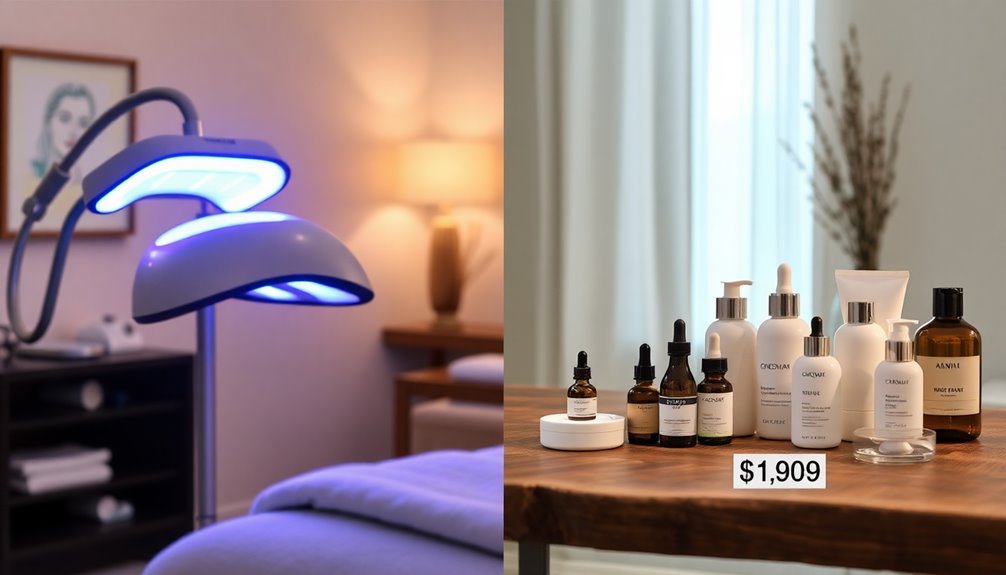
While considering skincare options, understanding the cost can help you make an informed choice.
LED light therapy sessions typically range from $25 to $85, while chemical peels can vary from $45 to $250.
Laser treatments are significantly pricier, costing between $1,000 and $3,500 per session.
If you opt for microdermabrasion, expect to pay between $55 and $250.
Facials average around $63 but can go up to $120 for specialized types.
For home use, LED devices cost between $25 and $250, making them a more affordable long-term option. Regular use of LED therapy is recommended for optimal results, which can help justify the initial investment in treatments.
Keep in mind that most of these treatments aren't covered by insurance, so budgeting for out-of-pocket expenses is essential.
Versatility for Skin Issues
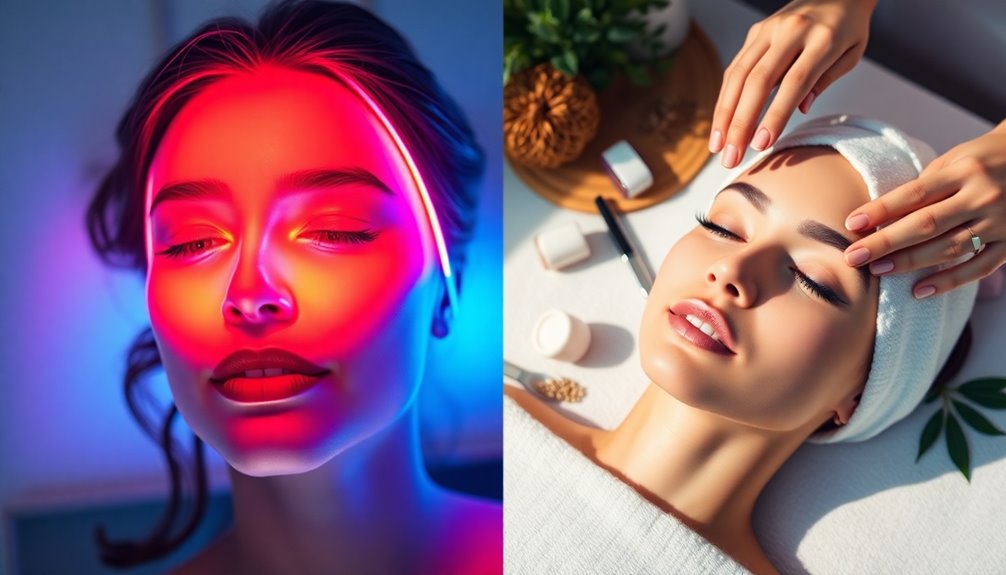
Many people are turning to LED therapy for its remarkable versatility in addressing a variety of skin issues.
Whether you're struggling with acne, hyperpigmentation, or fine lines, there's a specific light wavelength for you. Blue light targets acne-causing bacteria, while red light boosts collagen production to minimize wrinkles. Additionally, scientific research supports the efficacy of LED therapy, demonstrating up to 80% improvement in acne cases.
If you're looking to improve your overall skin tone and radiance, yellow light can help reduce inflammation.
Plus, LED therapy isn't limited to just aesthetic concerns; it can treat conditions like psoriasis and even aid in healing muscle pain.
The customizable nature of these treatments allows you to address multiple skin issues simultaneously, making LED therapy a comprehensive solution for your skincare needs.
Safety for All Skin Types
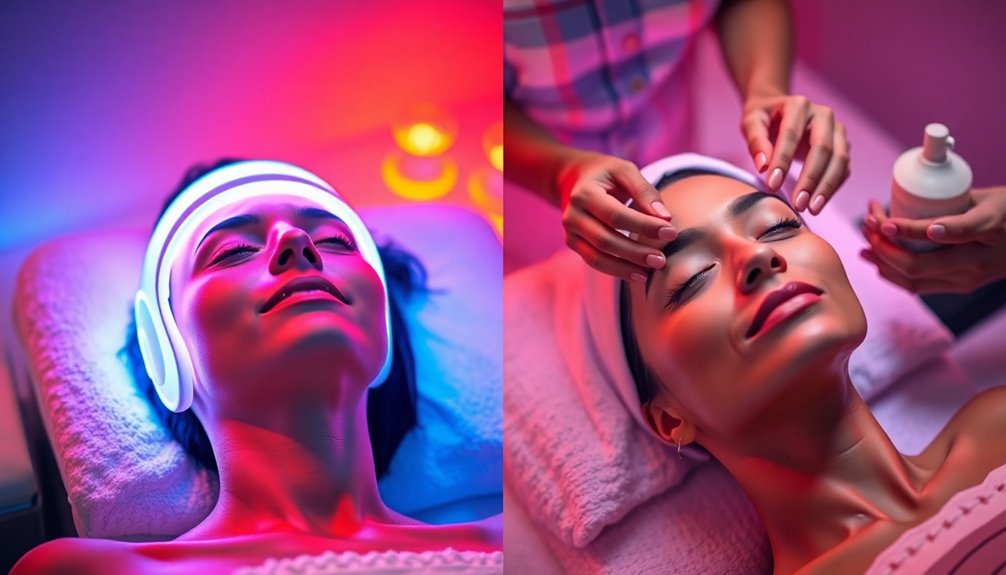
When it comes to skin treatments, LED therapy stands out for its safety across all skin types and tones. Unlike traditional methods, it doesn't emit harmful UV rays, making it suitable for everyone, including those with dark or sensitive skin. It is regularly safe for wound healing and sunburn prevention, with no recovery time needed unlike other cosmetic procedures.
You won't need to worry about downtime or recovery, as LED therapy is non-invasive and poses no side effects for most users. While it's important to wear protective goggles near your eyes, this treatment can be used regularly to maintain your skin health.
If you're pregnant, just consult with a doctor before starting. Overall, LED therapy offers a safe and effective option that you can easily incorporate into your skincare routine.
Professional Treatments
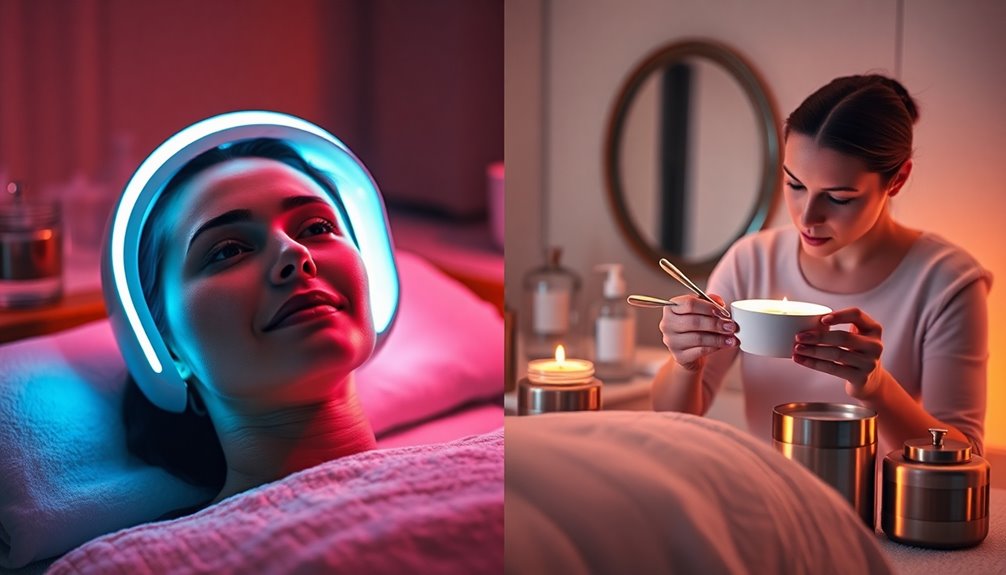
As you explore skincare options, professional treatments like LED therapy can significantly enhance your results.
This innovative approach offers a non-invasive solution for various skin concerns, from acne to aging. Blue LED light targets acne-causing bacteria, while yellow light improves skin tone and reduces inflammation. Red LED light stimulates collagen production, helping to smooth fine lines. Additionally, LED therapy is suitable for all skin types, making it accessible for everyone looking to improve their complexion.
Unlike chemical peels or laser treatments, LED therapy requires no downtime, making it a convenient choice. By integrating professional sessions into your routine, you can enjoy cumulative benefits over time.
Plus, trained practitioners use medical-grade devices to customize treatments, ensuring optimal outcomes tailored to your skin's unique needs. Embrace this versatile option for a healthier, more radiant complexion.
At-Home Treatment Options
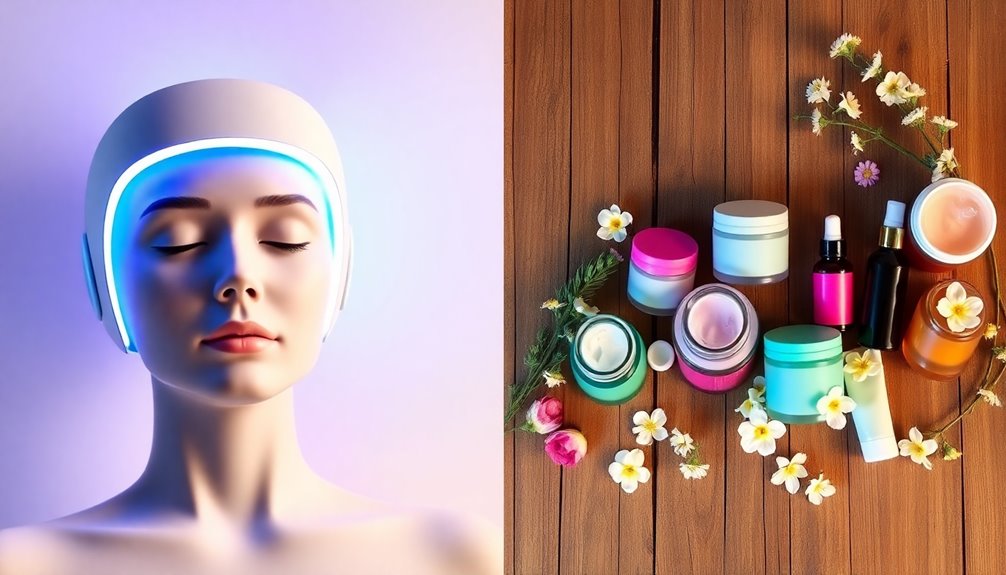
At-home LED therapy offers a convenient way to enhance your skincare routine without the need for professional visits.
These devices effectively reduce inflammation, promote healing, and boost collagen production, making them ideal for tackling issues like acne, rosacea, and signs of aging.
By using a combination of red and blue light, you can target specific concerns such as acne-causing bacteria and hyperpigmentation.
The quality of at-home devices varies, so opting for medical-grade options usually yields better results.
Plus, they're non-invasive and painless, making them a hassle-free choice.
Not only are they cost-effective compared to professional treatments, but they also improve the absorption of your skincare products, maximizing their effectiveness.
Additionally, high-quality LED sources can effectively treat conditions like eczema and psoriasis, enhancing the overall benefits of at-home treatments.
Treatment Frequency
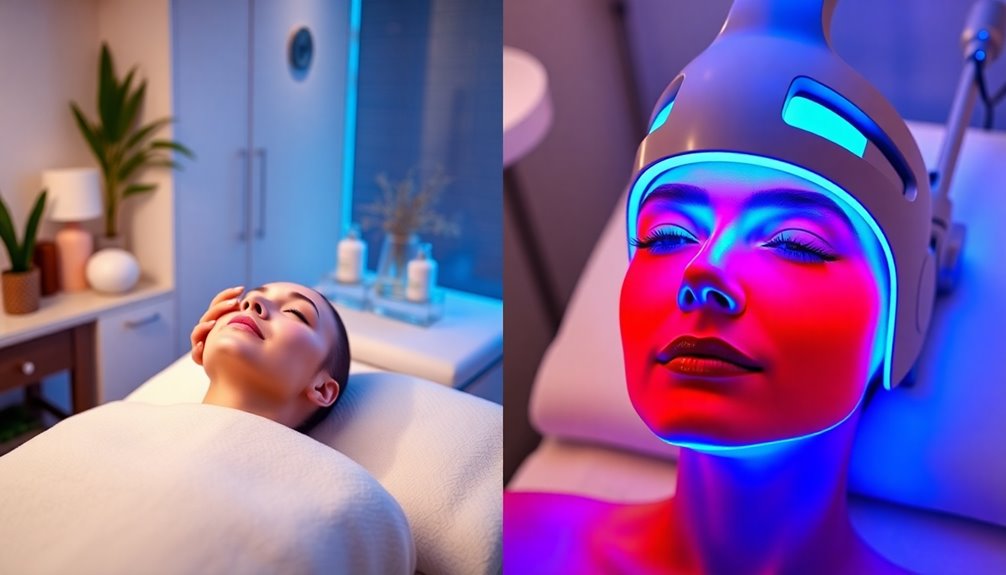
Finding the right treatment frequency is key to maximizing the benefits of both LED therapy and traditional skincare treatments.
For LED therapy, if you're using low-power devices, aim for daily or twice-daily sessions. With medium-power devices, you can go every other day or daily, while high-power devices work best two to three times a week. Keep sessions to about 10-30 minutes. It is important to remember that more frequent treatments may lead to skin irritation, so monitor your skin's response closely.
For traditional skincare, schedule treatments every 4-6 weeks for general maintenance. If you have oily or combination skin, start every two weeks, then shift to monthly.
For dry or sensitive skin, once a month is ideal. Address specific concerns like acne weekly or bi-weekly, tapering as your skin improves. Balance is essential for best results.
Skin Type Considerations
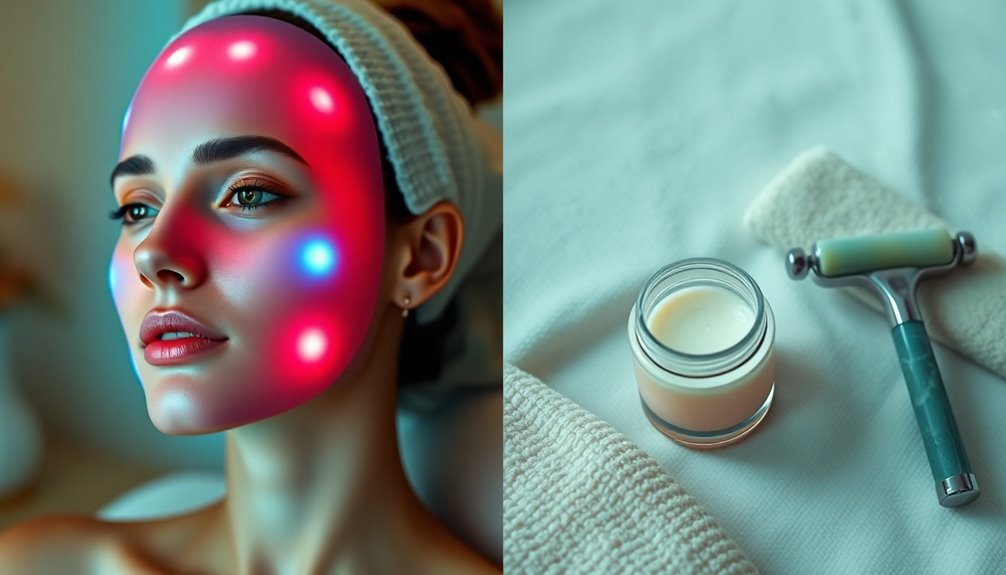
When considering LED therapy, it's crucial to tailor your approach based on your skin type to achieve the best results.
If you have oily skin, blue LED light therapy effectively targets acne-causing bacteria and reduces oil production. This treatment not only addresses breakouts but also promotes cellular activity, enhancing overall skin health.
For dry or sensitive skin, red or near-infrared light is gentler, promoting healing and minimizing irritation.
Combination skin benefits from customizable treatments, allowing you to address both oily and dry areas.
Normal skin can enjoy versatile benefits from LED therapy, boosting collagen production and promoting overall skin health without downtime.
Long-Term Effects
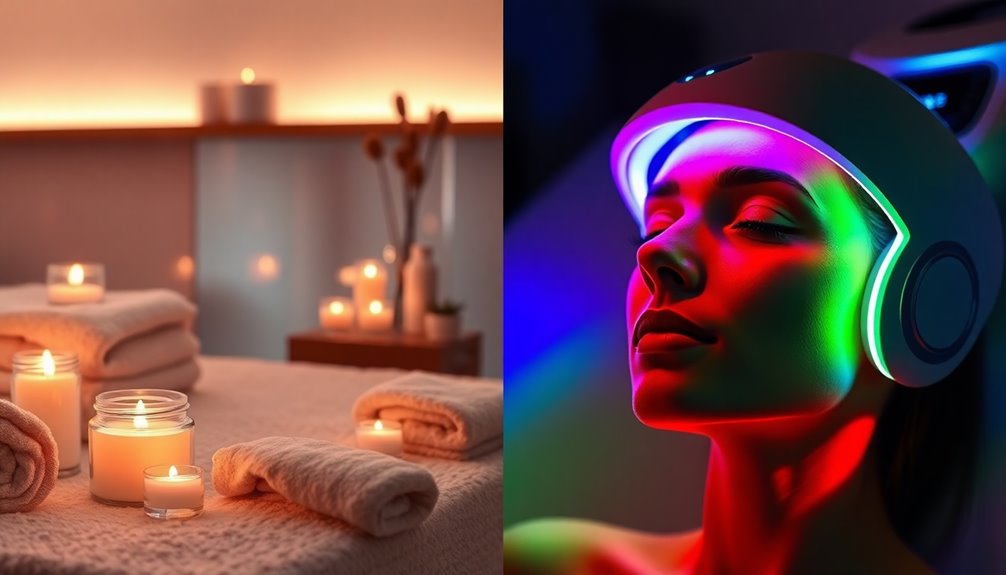
While LED therapy can offer numerous benefits for your skin, it's essential to be aware of the potential long-term effects that may arise with excessive use.
Overdoing it can lead to increased skin sensitivity and irritation, disrupting your skin's natural barrier and possibly causing allergic reactions. You might notice redness and dryness, as well as diminishing returns, where your skin becomes less responsive over time. Additionally, prolonged exposure can heighten oxidative stress, accelerating signs of aging like wrinkles and fine lines. It may even trigger acne breakouts if your skincare routine isn't properly maintained.
To maximize benefits, use LED therapy in moderation and consult a dermatologist to ensure safety and effectiveness. Regular consultations can help tailor your routine to your skin's needs and mitigate risks associated with excessive use.
Frequently Asked Questions
How Long Do LED Light Therapy Sessions Typically Last?
LED light therapy sessions typically last between 10 to 30 minutes, depending on the treatment type and intensity.
For skincare, you might find shorter sessions of about 10 minutes effective, while mood-related treatments like depression often require 20 to 30 minutes.
It's essential to maintain consistency, as regular sessions can lead to noticeable improvements over time.
Start with shorter durations and gradually increase as you get more comfortable with the therapy.
Can I Use Makeup After LED Light Therapy?
Imagine your skin like a delicate flower just watered; it needs time to soak up the moisture.
After LED light therapy, your skin might be a bit sensitive, so it's best to wait about 30 minutes to an hour before applying makeup.
Consider using gentle products and layering them lightly.
Your skin's in healing mode, so treat it with care to avoid irritation, ensuring your makeup looks its best!
What Should I Do Before an LED Light Therapy Session?
Before your LED light therapy session, make sure to cleanse your skin thoroughly.
Remove all makeup and use a gentle, soap-free cleanser. Exfoliate with an enzyme powder cleanser to prep your skin, and avoid applying any serums or moisturizers beforehand.
After cleansing, apply a hyaluronic acid serum to hydrate your skin.
Don't forget to sterilize the LED device to ensure it's ready for your treatment.
Following these steps will enhance your overall experience!
How Often Should I Use LED Therapy for Best Results?
To get the best results from LED therapy, aim for 3-4 sessions a week for 4-6 weeks.
After that, you can switch to maintenance sessions once or twice a week.
Depending on the specific type of LED therapy you're using, like red or blue light, session duration usually ranges from 5 to 20 minutes.
Be cautious about overusing it, as too much can lead to skin irritation or other side effects.
Are There Any Contraindications for LED Light Therapy?
LED light therapy can work wonders for your skin, but it's not all sunshine and rainbows.
You need to be cautious about contraindications. If you have sensitive skin, certain medications, or health conditions, it mightn't be the best choice for you.
Always protect your eyes and consult a dermatologist beforehand, especially if you're pregnant or have undergone previous treatments.
Safety first, so you can enjoy those glowing results!
Conclusion
So, if you thought LED therapy was just a fancy light show, think again! While traditional skincare treatments might seem like the tried-and-true option, LED therapy's non-invasive perks and versatility could turn your skin routine into a glowing success. Plus, who wouldn't want to combat skin issues from the comfort of home? In the battle of bright lights versus old-school creams, it looks like the future's shining a bit brighter—literally! So, are you ready to embrace the glow?
